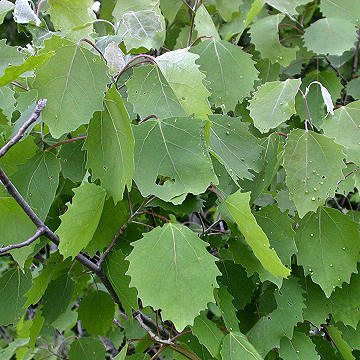

Populus grandidentata - (image 1 of 5)
Taxonomy
Family: Salicaceae
Habitat
Upland woods, often on dryer soil than P. tremuloides. Establishes in openings in or next to woodlands. Most frequent on gentle slopes.
Associates
Distribution
Nova Scotia west to MN, south to NC, TN, and northern MO.
Morphology
Deciduous tree to about 70'. Stems stout, round, red-brown become greenish-gray. Leaves alternate, dark green above, at first pubescent below but soon glabrous or glabrescent, about as long as wide, with mostly 6-10 large, marginal teeth on a side, mostly 5-12 cm. Bark light greenish-gray when young, becoming dark brown and furrowed with age. Flowers dioecious, in catkins appearing before the leaves; individual flowers solitary, inserted on a disk subtended by a bract; male flowers with 5-12 stamens; female flowers with 2 linear, bifid stigmas. Fruit a narrowly conic capsule, to 5 mm long; seeds cottony.
Notes
Flowers March to May
Wetland indicator: Facultative Upland
A fast growing and usually short-lived tree. Most abundant in the northern part of its range.
References
Dirr, Michael A. 1998. Manual of Woody Landscape Plants:
Their Identification, Ornamental Characteristics, Culture, Propagation and Uses.
5th ed. Champaign, Illinois: Stipes Publishing L.L.C.
Gleason, Henry A. and A. Cronquist. 1991. Manual of Vascular Plants of Northeastern United States and Adjacent Canada. Second Ed.
The New York Botanical Garden. Bronx, NY.
Swink, F. and G. Wilhelm. 1994. Plants of the Chicago Region.
Indiana Academy of Science. The Morton Arboretum. Lisle, Illinois.
|
Michael Hough © 2005 |